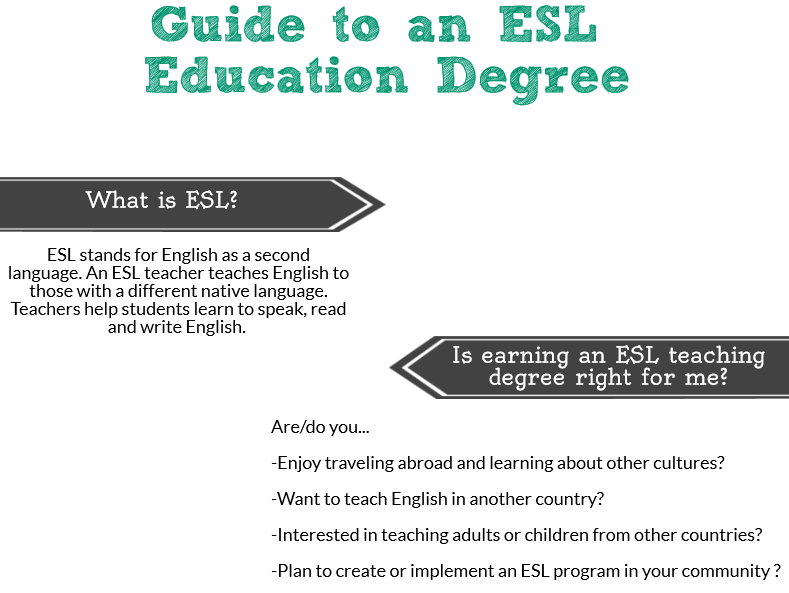English-as-a-Second-Language instructors work domestically and abroad to teach English language, writing, and culture to non-native speakers. It's natural to be excited and nervous about the idea of earning a degree over the Internet. Since we know you have lots of questions about going back to school online, we have written this quick, easy-to-read "Mini-Guide to Online ESL Education Degrees" to help give you the facts that you need to make the right choice for you.

1. What does it mean to be a English-as-a-Second-Language (ESL) teacher? What is ESL education?
ESL stands for English as a second language. ESOL stands for English for speakers of other languages. EFL stands for English as a foreign language. All of these terms refer to the use or studying English by speakers with a different native language. These terms are most commonly used in relation to teaching and learning English.
2. Is an online ESL teaching degree right for me?
Think about an online ESL teaching degree if you:
- Enjoy traveling abroad and learning about other cultures, and want to teach English in another country
- Are a current ESL teacher looking to upgrade your skills
- Are interested in teaching ESL to adults or children from other countries in the United States
- Plan to create and/or implement an ESL program in your community
3. What are the educational requirements to become a special education teacher?
In the U.S., teaching requirements vary from state-to-state, but an ESL teacher is required to hold a bachelor’s degree in English, at a minimum, with additional coursework or a graduate degree in Teaching English as a Second Language or Teaching English as a Foreign Language. A graduate degree is required event for entry level positions at colleges and universities. In the K-12 grade levels, ESL teachers will also need teacher certification. If teaching ESL overseas, a bachelor degree will be helpful in obtaining an ESL teaching position in academic settings.
4. What are some courses I might take to earn an ESL teaching degree?
Here are some courses you might take to earn a degree in English-as-a-Second-Language instruction:
- Contemporary Semantic Theory
- Structure of English
- Special Topics in Linguistics
- Research Methods in Language Studies
- Sociolinguistics
- Psycholinguistics
- Corpus Linguistics
- Pragmatics and Teaching Oral Skills
- Bilingualism and Language Acquisition Research
- Methods of Teaching Multilingual Students
- Assessment of Language Learners
5. What types of jobs involve teaching English as a second language?
Here are just a few types of jobs in the ESL teaching field:
- Adult Education
- Teaching ESL in public schools in the U.S.
- Teaching ESL at schools and universities abroad
- Teaching for social service organizations
- Teaching at private language schools
- Teaching employees at businesses, both in the U.S. and abroad
6. What types of jobs involve teaching English as a second language?
Here are just a few types of jobs in the ESL teaching field:
- Kindergarten and Elementary School Teachers
- Adult Literacy and High School Equivalency Diploma Teachers
- Middle School Teachers
7. What is the work environment like for an ESL teacher?
Teachers of English as a second language help students learn to speak, read and write the English language. Much of this is done in the context of real-life situations to promote learning. Along with teaching grammar and writing, ESL teachers also assist their students in adjusting to American culture, if they are teaching in the U.S. ESL teachers work with students from a wide variety of cultural backgrounds, and need to be prepared to work with students from many different age groups and English language skill levels. Students may have significant educational experience in their home countries to little or none at all. Some students may progress further in their studies than others as a result, and ESL teachers must tailor their approach for each student. ESL teachers must prepare lesson plans, stay current in their field and learn the latest computer applications for computers in the classroom.
8. What is the earning potential for an ESL teacher?
According to the U.S. Bureau of Labor Statistics, Adult Literacy and High School Equivalency Diploma Teachers earned a 2012 median pay of $48,590. The job outlook from 2012 to 2022 is growing at 9%, which is as fast as average. [1]
[1]bls.gov/ooh/education-training-and-library/adult-literacy-and-ged-teachers.htm
